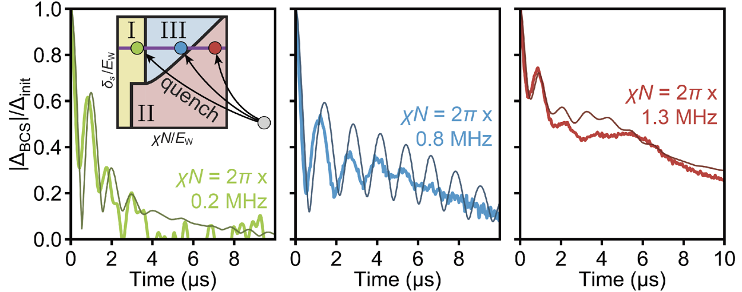QSA scientists developed a unique programmable quantum simulator capable of predicting the out-of-equilibrium dynamics of superconductors
The science: Improving our understanding of superconductivity is critical to engineer next-generation quantum information systems. QSA researchers developed a programmable neutral atom quantum simulator, consisting of ultracold atoms trapped in an optical cavity capable of simulating the out-of-equilibrium dynamics of Bardeen-Cooper-Schrieffer (BCS) superconductors. Using this new capability all three distinct phases of dynamics predicted to exist in theory have been observed for the first time.
The impact: Quantum simulation offers a path to understanding a broad range of physical phenomena in quantum information science. The programmable, cavity quantum electrodynamics based, simulator allows researchers to fully explore the out-of-equilibrium physics in superconductors and opens up exciting prospects for quantum simulation, including the potential to engineer unconventional superconductors and for increasing coherence time for quantum sensing.

Observation of the three BCS dynamical phases in a single parameter scan. Time traces of the BCS order parameter |ΔBCS| normalized to the value at t=0 corresponding to phase I (left), phase III (middle), and phase II (right) respectively. Phase I is characterized by a rapid decay of |ΔBCS| to 0. Phase II features a nonzero value of |ΔBCS| at long times, with damped oscillations at short times. Finally, phase III features long-lived oscillations in the order parameter. We simulate these phases by first initializing our atomic ensemble with a π/2 pulse along the relevant optical transition, rapidly turning on single particle energy terms, and then letting the system evolve under the Hamiltonian, with t=0 defined by the end of the initialization pulse. The inset shows the explored cut through the dynamical phase diagram. Post-quench parameter values of the interaction strength (ΧN) and single-particle energy terms (δs,EW) are identified by the green (phase I), blue (phase III), and red (phase II) points, respectively. The ΧN/2π=0.2 MHz trace is smoothed for clarity.
Summary: While superconductivity naturally emerges at thermal equilibrium, it can also emerge out of equilibrium when the system’s parameters are abruptly changed. The resulting out-of-equilibrium phases are predicted to occur in real materials and ultracold fermionic atoms but have not yet all been directly observed. We trapped ultracold atoms in an optical cavity to build a programmable quantum simulator. Our programmable simulator is capable of simulating the out-of-equilibrium dynamics Bardeen-Cooper-Schrieffer (BCS) superconductors, where electrons with opposite momenta bind into Cooper pairs due to an attractive interaction mediated by phonons in the material. Using this new capability all three distinct phases of dynamics predicted to exist in theory have been observed for the first time.
Contact:
Ana Maria Rey – arey@jila.colorado.edu
James K. Thompson – jkt@jila.colorado.edu
Focus Areas: Quantum simulation, neutral atoms, quantum control
Institutions: JILA, NIST, University of Colorado, Boulder, Max-Planck-Institut für Kernphysik, University of Oklahoma,
Citation: Young, D.J. et al., Observing dynamical phases of BCS superconductors in a cavity QED simulator. Nature 625, 679-684 (2024)
Funding Acknowledgement: This material is based upon work supported by the US Department of Energy, Office of Science, National Quantum Information Science Research Centers, Quantum Systems Accelerator. We acknowledge additional funding support from the National Science Foundation under Grant Nos. 2317149 (Physics Frontier Center) and OMA-2016244 (Quantum Leap Challenge Institutes), the National Institute of Standards and Technology, the Army Research Office of the Defense Advanced Research Projects Agency (Grant Nos. W911NF-19-1-0210 and W911NF-16-1-0576) and the Air Force Office of Scientific Research (Grant Nos. FA9550-18-1-0319 and FA9550-19-1-0275).